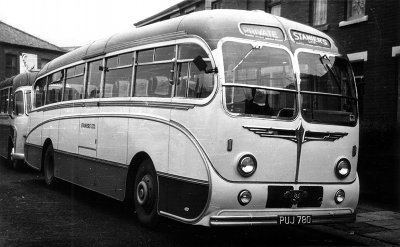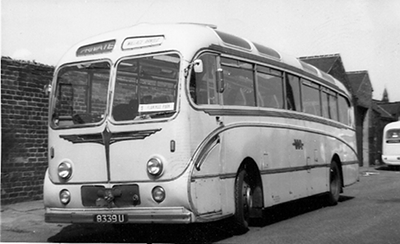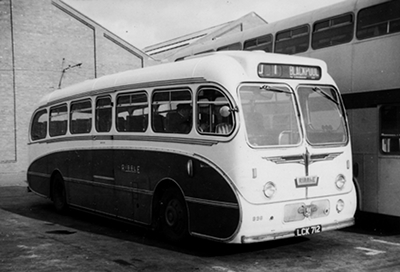Burlingham’s flock of Seagulls - Part 2
Burlingham’s flock of Seagulls - Part 2
Not read Part 1 Click here
The move to lighter designs (by both bodywork and chassis manufacturers) had been occasioned by tumbling revenues as operators felt the pinch from increasing private car ownership. Similar economic pressures led operators to demand a front entrance version of the Seagull which could be one-man operated on scheduled express routes if circumstances demanded. This need was met at the 1954 Commercial Motor Show by the Seagull Mark 4. Surprisingly the move from a central entrance to one at the front did little to upset the Seagull design as Burlingham decided to retain the short central window bay minus the indentation for the sliding entrance door. The Mark 4 also offered the “Ribble style” roof box destination display as a factory option to all purchasers of the new variant.
The centre entrance Mark 3 continued to be available alongside the Mark 4 and was also given the factory option of a roof box display although few if any were built with this beyond the original batch for Ribble. For certain chassis types (notably Sentinel) the Mark 2 remained in production until the end of 1955, mainly as a means of using up the left over stock of Mark 2 style body parts languishing at Burlingham’s Blackpool factory.
All Seagull models up to this point had featured a two-piece rear windscreen similar to those which the bodybuilder had used on earlier front engined chassis types. At the 1956 Commercial Motor Show the Seagull Mark 5 introduced a new rear end design incorporating a single-piece window flanked by two glazed corner pillars which gave the appearance of a three-piece unit. It was, by most observers, considered less attractive than the original configuration.
 The Mark 5 introduced a new rear end and was available from 1956 to 1958. Most of the breed also featured flat glass front windscreens but Whittle of Highley was an important customer and preferred the older style of front end. PSUC1/2 Tiger Cub PUJ 780 was delivered to them in 1958, passing to Stanier of Newchapel in 1961 as seen in this shot. The livery was cream and red. After Stanier sold out to PMT in 1965 the “flying sword” emblem was removed and it was fitted with bus seats for stage carriage work. Sister vehicle PUJ 781 (in its original configuration) is preserved in Whittle’s livery. Another example of a 1958 Mark 5 with opening front windscreens can be found under the “Yorkshire Traction” heading on this website.
(Bill Jackson Collection)
The Mark 5 introduced a new rear end and was available from 1956 to 1958. Most of the breed also featured flat glass front windscreens but Whittle of Highley was an important customer and preferred the older style of front end. PSUC1/2 Tiger Cub PUJ 780 was delivered to them in 1958, passing to Stanier of Newchapel in 1961 as seen in this shot. The livery was cream and red. After Stanier sold out to PMT in 1965 the “flying sword” emblem was removed and it was fitted with bus seats for stage carriage work. Sister vehicle PUJ 781 (in its original configuration) is preserved in Whittle’s livery. Another example of a 1958 Mark 5 with opening front windscreens can be found under the “Yorkshire Traction” heading on this website.
(Bill Jackson Collection)
The Mark 5 was intended to replace both the Mark 3 and Mark 4 (the remaining Mark 2 components had finally run out) and as a result could be ordered with either a front or central entrance and with an optional roof box display. The prototype, an AEC Reliance for North Western, featured the original style of slightly curved front windscreens with hinged top sections but production examples would carry flat glass windscreens, still held in place by a central pillar but without the horizontally hinged top halves. This further decreased the variants visual appeal.

Wallace Arnold’s PSUC1/2 Tiger Cub 8339 U was also delivered in 1958 but featured the standard flat glass front windscreen of the Mark 5. After a couple of seasons on extended coach holiday work it was demoted to local private hires and excursions from the Leeds base. Sister vehicle 8338 U was transferred to the Hardwicks subsidiary in Scarborough for similar work.
(Paul Haywood Collection)
Seagulls or Ugly Ducklings?
While the Mark 5 was considerably less elegant than the original design of 1950, far worse was about to come. In September 1957 Burlingham introduced the Seagull Mark 6 which abandoned the previous Marks’ side window configuration (featuring slender metal pillars between windows and the narrower central bay) and utilised much thicker pillars and glazing fitted into “window pans”. This was at the request of Ribble Motor Services and was intended to make the replacement of broken glazing an easier task.

Ribble was another important customer which got what it wanted. Unfortunately this was the result, and many saw the Mark 6 as the beginning of the end for the Seagull. PSUC1/2 Tiger Cub LCK 712, Ribble’s fleet number 998, is seen in Blackpool’s Coliseum coach station parked next to one of the company’s “White Lady” Atlantean coaches. It had just arrived on express service J1 from Leeds via Keighley. Delivered in July 1958, it was sold to contractor George Wimpey in August 1969.
It probably did, but it also made the Mark 6 look like some kind of unfortunate hybrid produced by a coach and a service bus which had surreptitiously mated in the depot in the dead of night. Apart from the Ribble order very few were sold with most operators preferring to stick with the Mark 5 which continued to be produced. As with the Mark 2, left over components were used in the production of bodies for rarer chassis, with Mark 6s being fitted to Guy Arab LUFs for Harper Brothers of Heath Hayes. Total production of the Mark 6 was less than 60, a record low for any of the Seagull variants.
A record low until 1958, that is! In that year the sizeable coach holiday operator Sheffield United Tours asked Burlingham and Plaxton to come up with coach designs which would offer their customers a better view of passing scenery. Burlingham offered the Seagull Mark 7, Plaxton the Panorama, and small batches of each design were acquired by S.U.T. for comparison in service. The result of these trials may be judged from the fact that all of S.U.T.’s future orders for this specification of bodywork went to Plaxton.
Despite this setback Burlingham’s management decided to put the Mark 7 into large scale production, apparently in the belief that such vehicles would quickly monopolise the coach market and that a substantial chunk of this market could be claimed by the Mark 7.
There were two tragic flaws to this strategy. Firstly the Seagull Mark 7 was an unattractive creature, featuring a “chopped off at the back end” version of the famous tank moulding and relatively tiny roof windows in the front dome area which looked like money-box slots compared to other contemporary designs. It lacked any of the elegance of earlier Seagulls. Secondly the coaching industry proved to be more conservative than Burlingham’s management had believed and didn’t move to “larger window” designs with any great enthusiasm until 1961-62. The Mark 7 was a financial disaster and it became an indisputable fact that Burlingham had lost its way. For the first time in the company’s existence Burlingham found itself selling more double-decker buses than coaches. Less than ten years after the all-conquering triumph of the original Seagull the company was facing insolvency.
Neville Mercer
06/2010
To read Part 3 Click Here
Seagulls or Ugly ducklings. Excellent part 2 but slight inaccuracy with SUT saga. As happy Burlingham customers, SUT made an approach initially to them for panoramic windows. Burlingham turned them down. SUT's first Plaxtons had been very low milage second hand Regal IVs from Altricham Coachways - whose quality had impressed. Plaxtons said yes and the Mark 7 was a failed attempt by Burlingham to get SUT's custom back. They only sold one more coach - a Ford - to SUT. The rest is history.
David Oldfield
After re-examining my records I find that David Oldfield is right in his statement that SUT never actually acquired any Mk 7 Seagulls. I knew that Burlingham had been approached by them and this knowledge got juxtaposed in my aging mind with a “head-on” photograph in my collection of an SUT Seagull (3280 WB of 1958) which appeared to be a Mark 7 from the shape of the front dome window lights – they are of the Mk 7 “money-box slot” style. One should, of course, never make presumptions! A side view of a machine from the same batch on an Internet site reveals that the 1958 SUT Seagulls were in fact centre-entrance Mark 5 variants with the hinged windscreen option at the front. Perhaps they were fitted with the Mk 7 style front domes as an experiment by Burlingham to see what the result would look like. The answer is not very nice. Thanks for the correction, David, and for your kind comments on the article in general.
Neville Mercer
Comments regarding the above are more than welcome please get in touch via the 'Contact Page' or by email at obp-admin@nwframpton.com
If you have a bus related article that you would like to appear on this site please get in touch via the 'Contact Page' or by email at obp-admin@nwframpton.com
All rights to the design and layout of this website are reserved
Old Bus Photos from Saturday 25th April 2009 to Wednesday 3rd January 2024